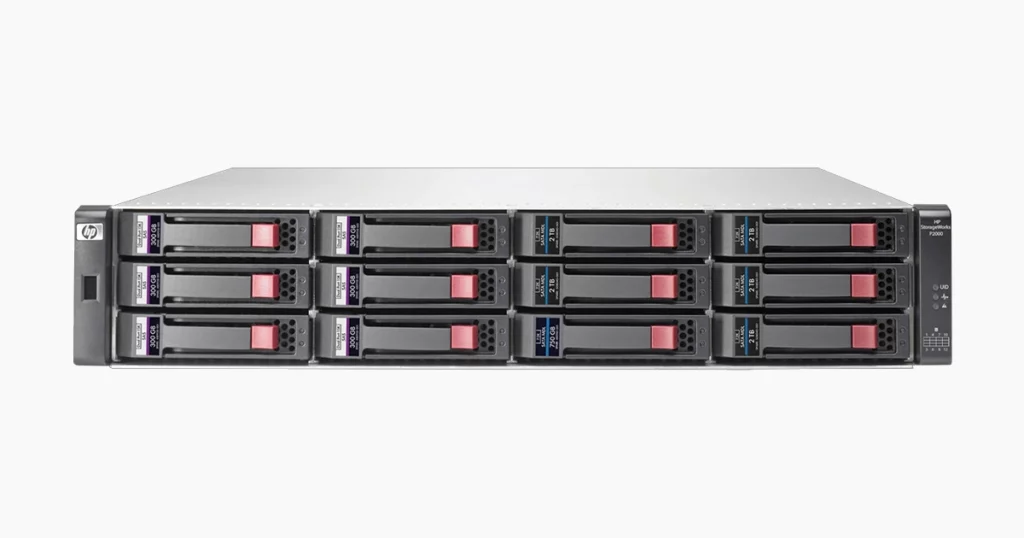The Critical HPE P2000 Failure
A Florida based company experienced a severe HP StorageWorks P2000 outage that cut off access to enterprise data. The P2000 SAN consolidated large volumes of business critical information, so when multiple disks became unreadable the impact on operations was immediate.
Complicating matters, the platform is end of support. With no vendor assistance available, options narrowed and risk increased. The IT team attempted a disk swap, but two additional drives soon entered a degraded state and the array could not rebuild.
At that point the organisation faced a stark choice: wait indefinitely for unsupported parts or engage specialists to prevent permanent loss. The incident underscores how essential a reliable SAN is to business continuity and why timely escalation is non negotiable.
For context on platform strategy, see our article comparing SAN and NAS architectures.

About the HPE StorageWorks P2000 System
The HP StorageWorks P2000 is a modular SAN array widely adopted by small and mid sized enterprises. It supports SAS or Fibre Channel connectivity and offers common RAID levels such as RAID 5 and RAID 6 to balance throughput and resilience.
In this engagement, the platform held essential customer data and internal records, so uptime was a hard requirement. As the P2000 is end of life, sourcing spares and firmware has become progressively difficult, which complicates recovery when hardware faults occur and increases the importance of HP P2000 MSA data recovery expertise.
For additional context on enterprise storage architectures, see our comparison of SAN and DAS.
Failure Incident and Early Symptoms
The company’s HP P2000 RAID estate presented clear warnings before the outage. The sequence unfolded as follows:
Initial drive failure. One SAS disk stopped responding, which raised an alert in the management console.
Drive replacement. The IT team swapped the failed disk expecting a routine rebuild.
Additional degradation. Two further disks soon entered a degraded state and the rebuild stalled.
Array inaccessibility. The system became unstable and users lost access to shared data.
Error diagnostics. Parity and synchronisation errors surfaced during RAID verification, confirming severe logical corruption.
Taken together, these symptoms pointed to a wider fault than a single disk issue and warranted a professional HP P2000 MSA data recovery engagement.

Challenges in Recovery
Recovering data from the HP StorageWorks P2000 involved several technical hurdles. Because the platform is no longer supported, sourcing compatible replacement disks and firmware was close to impossible through official channels.
During evaluation, our engineers identified key risks:
End of life hardware. Replacement parts and controller updates were unavailable via vendor routes.
Multiple degraded disks. With more than one failure in play, the array could not rebuild safely.
Inconsistent metadata. Corrupted parity and damaged metadata made logical reconstruction complex.
Unsupported firmware versions. Compatibility gaps blocked direct access to the RAID configuration.
These conditions materially increased the risk of permanent data loss if rebuilds were attempted without controls. For similar scenarios, refer to our guides on troubleshooting RAID failure and reasons for RAID data loss.
Our Data Recovery Process
After receiving the failed HP P2000 SAN, our engineers performed a full diagnostic assessment in a controlled laboratory environment. Each disk was examined for physical and logical faults before any action was taken, ensuring the recovery could proceed from a safe baseline.
Every disk was cloned using sector by sector imaging to preserve the original state and prevent further degradation. All subsequent work was carried out on replicas.
We rebuilt the RAID configuration manually, confirming disk order, block size, and parity rotation to establish the correct layout for HP P2000 MSA data recovery.
Using the verified parameters, we created a virtual RAID to access the data safely without modifying the client’s media.
Extracted data was validated with hash comparisons to confirm file integrity and completeness before packaging for return.
In complex cases, controller incompatibility can complicate access and layout interpretation. For further detail on how these issues are handled, see our guide on RAID controller failure recovery.

Outcome: Successful Data Restoration
Following detailed reconstruction and verification, our engineers completed a full recovery from the failed HP StorageWorks P2000 array. The dataset included customer records, accounting databases, and internal documentation required for day to day operations.
Post recovery, all files were written to a secure external device and validated by the client. The environment was back to a stable operating state within 72 hours of receipt, enabling the company to resume normal activity without loss of data.
This case confirms that even with unsupported or legacy hardware, a precise and methodical HP P2000 MSA data recovery approach can deliver full restoration while minimising downtime in enterprise estates.
Fast turnaround times for business-critical data
Key Lessons and Preventive Measures
This recovery underscores critical practices for organisations operating ageing or unsupported storage platforms:
Avoid legacy storage where possible. End of life systems lack firmware updates and compatible components, which elevates failure risk and complicates recovery.
Implement proactive RAID monitoring. Early alerts for degraded disks or parity errors can prevent full outages and reduce the scope of HP P2000 MSA data recovery efforts.
Maintain robust backup routines. Regular, tested backups and off site replication protect data during hardware incidents and speed operational recovery.
Plan timely platform upgrades. Replace outdated SAN units before manufacturer support ends to preserve parts availability and security patching.
To learn more about safeguarding enterprise estates, see our data loss prevention article. You can also review a related enterprise case covering HPE Nimble Storage recovery.
Conclusion
This HP StorageWorks P2000 case shows how expert intervention can restore critical data even when multiple disks fail and vendor support is no longer available. With disciplined diagnostics, secure imaging, and precise RAID reconstruction, it is possible to recover business data from complex enterprise systems.
If your SAN or RAID array becomes inaccessible or shows signs of degradation, do not attempt a rebuild without a professional assessment.
Contact RAID Recovery Services to arrange an evaluation and protect your data from further risk. Our specialists are available 24/7 to support enterprise grade recovery and HP P2000 MSA data recovery requirements.

Trust the experts with proven results
Frequently Asked Questions
What should I do when my HPE StorageWorks P2000 stops responding?
Power it down immediately and avoid any rebuild attempts. Running the system risks overwriting recoverable data. Engage a professional recovery team to evaluate the disks safely in a controlled environment.
Can data be recovered from an HPE P2000 with multiple degraded drives?
Yes, often. Engineers image each disk, reconstruct the RAID virtually, and then extract data from the rebuilt layout. Success depends on disk health and whether prior rebuild attempts wrote new metadata.
Why is recovery difficult on unsupported HPE models?
End of life platforms lack firmware updates and compatible parts, which complicates controller behaviour and layout access during recovery. These gaps increase risk if you attempt DIY fixes.
How long does enterprise SAN recovery take?
Timelines vary by capacity and fault profile. Most professional engagements complete within 48 to 72 hours after diagnostics, assuming no severe media damage.
Can RAID Recovery Services handle other HPE storage systems?
Yes. Our engineers support HPE SAN, NAS, and server estates, including Nimble and ProLiant environments, and deliver HP P2000 MSA data recovery using forensic imaging and virtual reconstruction.